






U.S. Olympians & Paralympians Association President

Dear U.S. Olympians and Paralympians,
We live in a singular and unique time never seen in the Modern Games Era. The IOC has cancelled Games due to World Wars, in 1916, 1940 and 1944, but they have never postponed a Games for one year.
Today we are in another World War, a global war against an infectious disease that has disrupted our lives, our routines, and taken our loved ones. While some trials have been held and athletes have qualified for Team USA, most competitions have been cancelled including all collegiate seasons and competitions. Olympic and Paralympic Training Centers have been closed and athlete’s ability to train has been completely upset. Team athletes are probably the worst affected due to social distancing health requirements. Athletes are adapting to a new and very challenging environment including an adjustment for a yet unknown competition season for next year.
Now is the time for all of us to remain open to finding solutions to support our athletes and our teams to enable them to overcome the exceptional challenges and realize their dreams. We will survive this, no matter the cost, because we love the Games and understand how sport motivates us, inspires us and unites us on the road to Tokyo 2021.
Please stay safe and healthy, follow all the hygiene best practices and social distancing to stop the spread of this disease. Reach out to each other and help one another in your community.
We are Team USA

In Olympic Spirit, Richard Fosbury


Squaw Valley Lake Placid
Led by hockey’s “Forgotten Miracle,” the U.S. performance in 1960 was one to remember.
By Paul D. Bowker Red Line EditorialThe first Olympic Winter Games in the American West featured an Olympic Village rising up in the Sierra Nevada mountains, an iconic U.S. upset and a touch of Walt Disney. Those are among the legacies of California’s Squaw Valley, a remote ski resort located 200 miles northwest of San Francisco, which is celebrating the 60th anniversary of the Winter Games held there.
The Olympic Winter Games Squaw Valley 1960 clearly marked a point of growth for the Winter Games. For the first time in Winter Games history, an Olympic Village for athletes was constructed. It consisted of four 75-bedroom buildings, big enough to house 750 athletes. Biathlon and women’s speedskating made their Olympic debuts, expanding the number of winter Olympic sports to eight and the number of total events to 27.
South Africa made its winter Olympic

Squaw Valley 1960 Olympic Winter Games, Men’s Ice Hockey Team, (US) gold
debut at Squaw Valley and was among 30 nations with 665 total athletes. The U.S. team was the biggest, with 79 athletes.
“The Olympic Winter Games
Squaw Valley 1960 clearly marked a point of growth for the Winter Games. For the first time in Winter Games history, an Olympic Village for athletes was constructed.”
Walt Disney was the head of Pageantry Committee, which oversaw the opening and closing ceremonies. And with it came the best of Hollywood. Danny Kaye performed. Karl Malden recited a prayer.
Bing Crosby and Roy Rogers showed up as well. And the Games were opened by Vice President Richard Nixon.
“They had all of the folks coming up from Hollywood,” said U.S. alpine skier Penny Pitou, who won two of the 10 U.S. medals, in an interview with the Atlantic. “All I remember is that there was something going on every night.”
Here’s a closer look at the U.S. medalists at Squaw Valley:
U.S. Men’s Ice Hockey Team Gold Medal
Twenty years before the iconic “Miracle on Ice” Olympic ice hockey match in Lake Placid, New York, the U.S. embraced
its underdog status and won its first ice hockey gold medal at Squaw Valley in what is known as the “Forgotten Miracle.”

Squaw Valley 1960 Olympic Winter Games – Figure Skating – Women’s Singles. On the podium, Carol Heiss (US) gold medalist, Sjoukje Dijkstra (Netherlands), silver medalist and Barbara Ann Roles (US) bronze medalist.
A group of amateurs mostly from Massachusetts and Minnesota stepped up for Team USA. Despite going just 10-4-4 in a pre-Olympic tour, the team came out fast with a 7-5 upset win over Czechoslovakia. The momentum continued into the six-team, round-robin medal round. Still undefeated, the U.S. beat the defending Olympic champion Soviet Union 3-2 – in the midst of the Cold War, no less – in the penultimate game before sealing the deal with a 9-4 win over Czechoslovakia. Roger Christian scored three times in the final period.
with 12 points on six goals and six assists. U.S. goalie Jack McCartan also became an American star, making 39 saves in a 2-1 victory over favored Canada in the medal round. Herb Brooks, who coached the U.S. miracle team to an Olympic championship in 1980, was cut from the 1960 team as a player.
Carol Heiss
Women’s Figure Skating Gold Medal
The 1960 team was led by two pairs of brothers: Roger and Bill Christian, and Bill and Bob Cleary. Bill Clearly led Team USA
Carol Heiss had made a promise to her mom. The world’s best women’s figure skater promised before her mother’s death in 1956 that she wouldn’t turn professional until she won an Olympic gold medal. That moment came in 1960. Heiss had won the silver medal in 1956, finishing runner-up to fellow American Tenley Albright. Heiss defeated Albright that same year at the world championships, beginning a stretch
of four straight world titles. She dominated the competition at Squaw Valley, placing first on every judge’s scoreboard in the compulsory figures, and then winning eight of nine judge’s scorecards in the free skate. Heiss never skated professionally, except for appearing as Snow White in the movie, “Snow White and the Three Stooges.” She married 1956 men’s Olympic gold medalist Hayes Jenkins in 1961, with 1960 men’s gold medalist David Jenkins becoming her brother-in-law.
David Jenkins
Men’s Figure Skating Gold Medal
David Jenkins won a bronze medal in his Olympic debut in 1956, when his older brother Hayes won it all. Four years later in Squaw Valley, David Jenkins completed the golden brother act. David won the gold medal in the men’s competition, beating out Karol Divín of Czechoslovakia and Don Jackson of Canada. David Jenkins, a three-time world champion, trailed Divín after the compulsory figures but had a strong free skate to win the gold medal.
Penny Pitou
Alpine Skiing Downhill And Giant Slalom Silver Medals
Before there was a Lindsey Vonn or a Mikaela Shiffrin, there was Penny Pitou. A rising 17-year-old at the 1956 Winter Games, she left her mark four years later in Squaw Valley when she became the first U.S. woman to reach the podium in an Olympic downhill race and also won the silver medal in giant slalom. Pitou was the only American to win two medals in 1960.
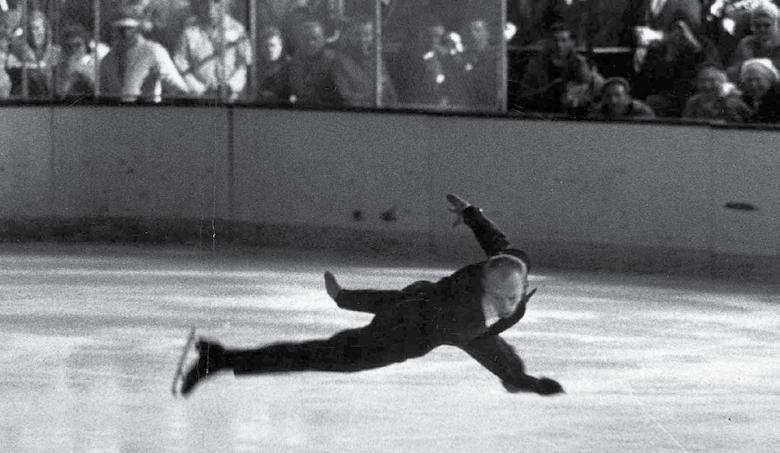
The New Hampshire native missed out on a gold medal in downhill by one second, finishing with a time of 1:38.6, as Germany’s Heidi Biebl won the event. Pitou’s margin in the giant slalom was even smaller, with Switzerland’s Yvonne Ruegg holding off the American by just one-tenth of a second, to 1:39.9 to 1:40.0.
Pitou was an attacking skier who was given the name “Tiger” by her coach and who skied on her high school boys ski team with her hair tucked into a cap so people couldn’t tell she was a girl. The strangest moment for her arrived in a cafeteria in Squaw Valley after the downhill was over. Vice President Richard Nixon approached her and expressed his sorrow for Pitou losing the race. “I can tell you I didn’t feel badly about it,” Pitou, who later went on to run a travel agency, told the Concord (N.H.) Monitor. “I thought the guy was crazy to think that winning a silver wasn’t winning something.”
Bill Disney
500-meter Long Track Speedskating Silver Medal
Bill Disney won a silver medal in his Olympic debut at Squaw Valley. Finishing second to the Soviet Union’s Yevgeny Grishin, Disney was the runner-up in the men’s 500-meter with a time of 40.3 seconds. Four years later, Disney was given the honor of being the U.S. flag bearer for the opening ceremony of the Olympic Winter Games Innsbruck 1964, and he later became a coach. His brother, Jack Disney, is a three-time U.S. Olympian in cycling.
Jeanne Ashworth
500-meter Long Track Speedskating Bronze Medal
Jeanne Ashworth, a former field hockey and softball standout at Tufts University in Massachusetts, made U.S. history at age 21 in Squaw Valley. With her bronze medal in the 500-meter race, Ashworth became the first U.S. woman to win an Olympic speedskating medal. She finished behind Helga Haase of East
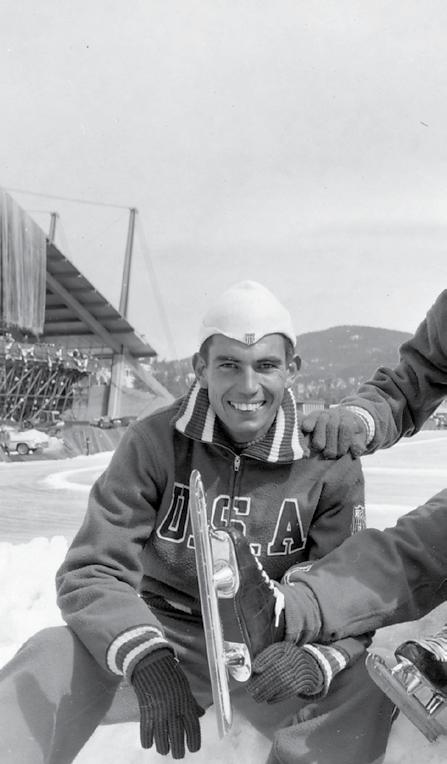
Squaw Valley 1960 Olympic Winter Games, Speed Skating. Part of the U.S. Olympic Men’s Speed Skating Team. Bill Disney (US) silver men’s 500m in center.
Germany and Nataliya Donchenko of the Soviet Union.
“It was all so lucky,” Ashworth would say years later, “because I didn’t know too much about what I was doing. I just went out and skated fast.”
Ashworth competed in three Olympic Games, but the first medal event in women’s speedskating history was the only time she reached the podium. She was on the organizing committee for the Olympic Winter Games Lake Placid 1980 and went to Greece to participate in the Olympic torch being brought to Lake Placid.
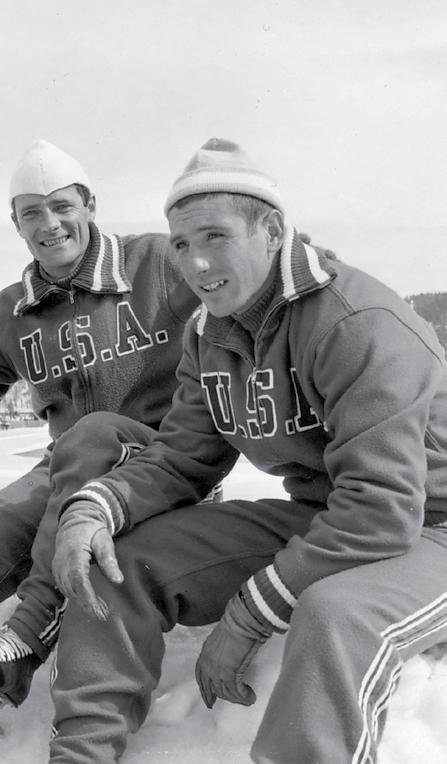
Barbara Roles
Women’s Figure Skating Bronze Medal
Barbara Roles won a bronze medal at Squaw Valley at her only Olympic appearance. Following U.S. star Carol Heiss as a virtual runner-up in the national championships in the late 1950s, Roles finished behind Heiss and Sjoukje Dijkstra of the Netherlands at the 1960 Winter Games. She retired from competitive skating after the Games, but then rejoined the national team following the 1961 plane crash that killed all 18 members of the U.S. figure skating team. She later became a coach for several skaters, including 1984 Olympic silver medalist Rosalynn Sumners.
Nancy Rouillard and Ron Ludington
Pairs Figure Skating Bronze Medal
Nancy Rouillard and Ron Ludington began their strong run in pairs by winning the 1957 national title. They followed that up with three more U.S. titles and Olympic bronze in 1960. They were among five U.S. figure skaters who won medals at Squaw Valley. The Ludingtons (they married in 1957 but later divorced) finished behind Canada’s Barbara Wagner and Bob Paul, and Germany’s Marika Kilius and HansJurgen Baumler. Ron Ludington went on to become a successful figure skating coach.
Betsy Snite
Alpine Skiing Slalom Bronze Medal
Betsy Snite blasted through her second run in the women’s slalom to capture a bronze medal at her second Olympic Games. Snite, who competed in slalom, giant slalom and downhill, was tied for fourth after the first run of slalom. She
cut nearly two seconds off in her second run, topping the field with a time of 55.5 seconds to move into third place for the bronze. She nearly reached the podium in giant slalom, finishing fourth and twotenths of a second behind Italy’s Giuliana Chenal-Minuzzo. Snite retired after Squaw
“South Africa made its winter Olympic debut at Squaw Valley and was among 30 nations with 665 total athletes. The U.S. team was the biggest, with 79 athletes.”
Valley and ran a sports shop in Vermont until her death in 1984.
Paul D. Bowker has been writing about Olympic and Paralympic sports since 1996, when he was an assistant bureau chief in Atlanta. He is a freelance contributor to TeamUSA.org on behalf of Red Line Editorial, Inc.

In the smallest municipality to host the Winter Games, Team USA earned 12 medals.
By Karen RosenDo you believe … it’s been 40 years? Yes! It has been four decades since the world descended on the quaint village of Lake Placid, New York, for the biggest winter sports spectacle in the universe.
The United States hosted the Olympic Winter Games Lake Placid 1980 and stole the show.
The U.S. men’s ice hockey team defeated the formidable Soviet Union in the “Miracle on Ice” game with the famous call by television announcer Al Michaels: “Do you believe in miracles? Yes!” Team USA went on to win the gold medal.
And Eric Heiden became the first – and still only – athlete to win all five speedskating distances from the 500-meter to the 10,000.
Heiden’s sister Beth added a bronze in the 3,000-meter. That meant only six countries, including the United States, won more medals than the Heiden family. And only the Soviet Union, East Germany and the U.S. won more gold medals.

Olympic Winter Games Lake Placid 1980, Ice Hockey, Men’s Ice Hockey, USA vs. USSR. USA won 4-3.
Linda Fratianne and Charlie Tickner came through with figure skating medals.
Speedskater Leah Poulos-Mueller added silver medals in the women’s 500- and 1,000-meter as Team USA won more medals than any other country in the sport. Norway, which finished with seven, was one of four countries with one gold medal.
Lake Placid was a second-time host, with the world returning 48 years after it first hosted in 1932. This was the first Winter Games in which machines were utilized to produce snow, a precaution given the exceptionally dry winter.
Roni the Raccoon proved to be a popular Winter Games mascot.
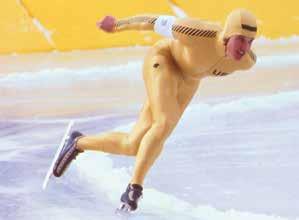
Olympic Winter Games Lake Placid 1980, Speed Skating. Eric Heiden (US) gold in men’s 500m, 1000m, 1500m, 5000m, 10,000m.
– population about 2,800 – is still the smallest municipality to host the Winter Games.
“Other small mountain communities will be able to follow our example in the future and stage Winter Games instead of relegating them to large cities, where athletes fade into the city commerce,” said Rev. J. Bernard Fell, president of the organizing committee.
Among the dozen medals earned by Team USA, 11 medals were on ice and only one on snow – alpine skier Phil Mahre winning silver in slalom.
With the popular gold-medal favorites in pairs, Tai Babilonia and Randy Gardner, forced to withdraw due to Gardner’s injury,
The press center was in the local high school and information was expedited through computers for the first time. Computerized scoring was also used for the first time, while bamboo poles made their last appearance in downhill skiing events.
The Adirondack village of Lake Placid
While the Olympic Winter Games Albertville 1992 featured French villages, the Savoy region had a population of 350,000. Lillehammer had a great smalltown Norwegian feel but had a population of about 27,000 in 1994.
Beijing in 2022 will be the largest city ever
to host the Winter Games.
Here’s a look back at Team USA’s medal winners in 1980.
A team of collegiate hockey players coached by Herb Brooks pulled off perhaps the biggest upset in sports when it knocked off the venerable Soviet Union 4-3 on Feb. 22.
However, many people don’t know that this was not the gold-medal game. In fact, Team USA had to again come from behind to beat Finland on Feb. 24 to secure the title.
The Team USA journey began with a sixman power play and a goal by Bill Baker with less than 30 seconds left in the opener to tie Sweden, 2-2. Team USA then defeated Czechoslovakia, 7-3, Norway, 5-1, Romania, 7-2, and West Germany, 4-2 (after trailing 2-0), in round-robin play.
That set up a Cold War showdown with the USSR, which had defeated Team USA, 10-3, in Madison Square Garden on Feb. 9.
“For us, it was still a hockey game,” team captain Mike Eruzione told ABC News in 2015. “It had nothing to do with what was happening globally but the crowd, their reaction was ‘us against them, freedom vs. communism, the threat of a Cold War.’”
Mark Johnson tied the score at 2-2 with a second remaining in the first period.
Vladislav Tretiak, considered the greatest goalie in the world, did not start the second period.
again to tie it at 3-3. Eruzione gave Team USA the lead with 10 minutes left to break a 3-3 tie. Goalie Jim Craig stopped 36 shots on goal.
“I kept saying, ‘I can’t believe we beat the Russians; I can’t believe we beat the Russians,’” said Eruzione, “and the celebration was incredible.”
But if Team USA didn’t win its final game, it would win the bronze and the USSR would still capture the gold.
Against Finland, Team USA trailed 2-1 after two periods before rallying to win 4-2. Phil Verchota broke the 2-2 tie and Rob McClanahan, set up by Johnson, put Team USA ahead for good.
The 21-year-old speedskater took the Olympic Oath for all athletes at the Opening Ceremony and then accomplished what he set out to do in his second Olympic appearance.
Heiden, who won world titles in 1977, 1978 and 1979, demonstrated his prowess in sprinting as well as his endurance. The three athletes paired with Heiden in the three shortest races all won silver medals. On Feb. 15, he started with the 500-meter, an event he lost to teammate Tom Plant at the previous week’s world sprint championships. Paired with world record holder Yevgeny Kulikov of the Soviet Union, Heiden pulled ahead on the final curve when Kulikov slipped slightly and finished in with an Olympic record of 38.03 seconds on the outdoor oval.
A day later, on Feb. 16, Heiden set another Olympic record in the 5,000 with a time of 7:02.29.
He then had three days off. On Feb. 19, Heiden set his third Olympic record, this time in the 1,000-meter, clocking 1:15.18, and followed that with his fourth, 1:55.44 in the 1,500.
On Feb. 23, he capped his Olympic career with both the Olympic and world records in the 10,000, sweeping around the oval in his distinctive yellow suit.
Trailing 3-2 in the third, Johnson scored

Olympic Winter Games Lake Placid 1980, Speed Skating. Leah PoulosMueller (US) silver medal in 500m and 1000m.
“People will often ask me, ‘What race is the most satisfying, especially from the Olympics?’” Heiden told Olympic Magazine. “I would tell you it is the 10,000 meters. It has to do with the fact that it is the longest race in speedskating. Those that do very well at it are technically very good skaters and they’ve had to put in a lot of time into this sport, they’ve had to really invest in their training and invest in speedskating. I’ve always cherished those who can skate the 10,000 meter
the best and I think one of the greatest races I ever had in my career was the 10,000 meters in Lake Placid.”
His performance has never been equaled. “What he did will never be done again,” said U.S. Olympic gold medalist Derek Parra, noting specialization in the sport.
“At the time I did not realize what I had accomplished, the implications of what it meant,” Heiden said. “I wanted to skate well in all the distances, and I felt I satisfied that dream. I was also relieved that my career was behind me and it was time to move on to other things. It was an exciting time in Lake Placid. It was a stressful time. And it was a time that I will never forget and something that I really cherish.”
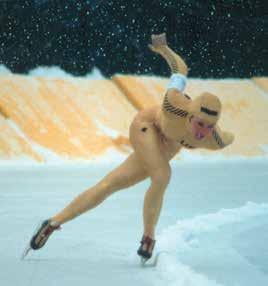
visit when I see them and they will say, ‘You are Eric Heiden the speedskater,’ and I’ll say, That’s correct, how did you know?’ ‘I told my friends who I was going to see for my ailment, they said, do you know who that is.’ Most of my patients have no clue that I had a career as an athlete, and I kind of like that; that means they come to me for what I am known for today which is to be a doctor and hopefully one of the best doctors that they can come visit.”
Leah Poulos-Mueller
500- and 1,000-meter Long Track Speedskating Silver Medals
In her third Olympic Winter Games, Poulos-Mueller followed her silver in the 1,000 at Innsbruck 1976 with two more runner-up finishes.
Poulos had retired after marrying fellow Olympian Peter Mueller, a gold medalist in 1976. But she came out of retirement for Lake Placid. On Feb. 15, she placed second behind Karin Enke of East Germany in the 500.
Two days later, she was paired with Natalya Petruseva of the Soviet Union. While Poulos-Mueller had the early lead, Petruseva pulled away for the win with an Olympic record of 1:24.10 to PoulosMueller’s 1:25.41.
She won the world all-round speedskating championships in 1979, becoming only the second American woman to earn the honor and the first in 43 years.
However, Heiden went into Lake Placid, her second Olympic Games, nursing an ankle injury that had been bothering her. She placed seventh in the 1,500 on Feb. 14, seventh in the 500 on Feb. 15 and fifth in the 1,000 on Feb. 17.
The final women’s race was the 3,000 on Feb. 20. The 20-year-old won the bronze with a time of 4:33.77. She was the only female athlete to place in the top seven in all four distances.
Later that year, Heiden was the first American woman to win a gold medal at the road cycling world championships in the road race. She was also an NCAA champion in 1983 in cross-country skiing a year after taking up the sport.
Her daughter, Joanne Reid, competed for Team USA in biathlon at the Olympic Winter Games PyeongChang 2018.
Charlie Tickner
Men’s Figure Skating Bronze Medal
Heiden, who went on to a cycling career, became an orthopedic surgeon and team doctor working with speedskaters.
“Most of my patients have very little insight into what I used to do as an athlete,” Heiden said. “And it’s not unusual for a patient of mine to come back at a second or third
Poulos-Mueller later became a lawyer focused on civil litigation and protecting constitutional rights.
Beth Heiden
3,000-meter Long Track Speedskating Bronze Medal
Like her older brother, Heiden had speed and endurance and raced every distance.
Tickner won the gold medal at the 1978 world championships, but two other world champions, Jan Hoffmann of East Germany and Vladimir Kovalev of the Soviet Union were also in the field, as well as European champ Robin Cousins of Great Britain.
Hoffman took the lead after the compulsory figures, with Tickner second and Cousins fourth and Kovalev dropping out after placing fifth.

Olympic Winter Games Lake Placid 1980, Figure Skating, Charlie Tickner, (US) bronze medal in men’s singles.
Cousins won the short program, earning one perfect 6.0, while Tickner placed only fifth.
That meant he went into the long program on Feb. 21 in third place.
“There is room for Charlie Tickner,” said Dick Button.
However, Tickner, 26, stepped out of his triple salchow and wound up third behind Cousins, who won the free skate, and Hoffman. U.S. teammates David Santee and Scott Hamilton were fourth and fifth, respectively. Hamilton went on to gold four years later in Sarajevo.
Tickner followed his Olympic performance with the bronze medal at worlds and the four-time national champion became a coach.
“It was a very serious injury,” Mahre told The Seattle Times in 2018. “Most doctors didn’t give me a chance of ever being competitive again.” He was skiing with a two- or three-inch metal plate and several screws in his left ankle.
On Feb. 22, he was the first skier out of the gate on the first run and posted the fastest time. But Ingemar Stenmark of Sweden overtook him with a blistering second run. Mahre finished half a second behind, 1:44.26 to 1:44.76.

Olympic Winter Games Lake Placid 1980, Alpine Skiing, Phil Mahre (US) silver in men’s slalom.
Linda Fratianne
Women’s Figure Skating Silver Medal
The 19-year-old Californian had a fierce rival in Anett Poetzsch of East Germany. Fratianne won the 1977 world title, lost to Poetzsch for silver in 1978 and regained the crown in 1979.
Poetzsch pulled substantially ahead in the compulsory figures in Lake Placid, with Fratianne third. Fratianne couldn’t make up the gap despite winning the short program within the scoring system that was established at the time, with point totals rather than placements carrying over.
In the free skate, Fratianne won first place votes from two of the nine judges – Japan and the United States – while Poetzsch took the rest in the closest women’s competition since 1920.
She had four scores of 5.9.
“Just a fine first-rate performance all the way around,” said Button, who noted that the “pressure was so extraordinary” on Fratianne.
Mahre had a bad fall in March 1979, breaking the tibia in his left leg and the joint where it joins the ankle.
In 1984, he won the gold medal in slalom with his twin brother Steve taking the silver. To top it off, Mahre’s wife gave birth to his second child and first son the same day.
The Mahre brothers went on to race cars, founded a ski training center and started a home construction company.

Olympic Winter Games Lake Placid 1980, Figure Skating, Linda Fratianne (US) silver medal in women’s singles.
LA84 Foundation welcomed 5-time Olympian and 3-time gold medalist Kerri Walsh Jennings to celebrate the 34th annual National Girls and Women in Sports Day. Kerri paid respect to the great Kobe Bryant and reminded the 100+ women and girls in the room to follow their truth, trust the journey, and appreciate the unifying power of sport.

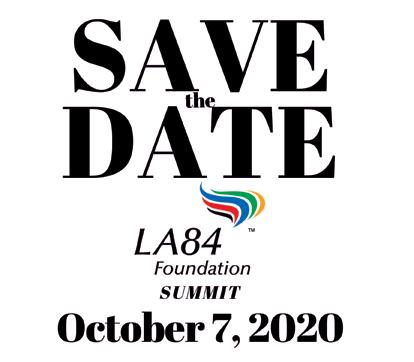



USA vs Canada Women’s Hockey Rivalry Series wrapped up in Anaheim on Saturday, February 8th. Fans set a record for the US Women’s National Team with 13,320 in attendance at Honda Center. The USA came out on top with a 4-3 win in overtime, winning the series 4-1. LA84 staff got to enjoy the big win along with Olympic Gold Medalist Julie Foudy and four-time USA Gymnastics Junior National Team member Katelyn Ohashi.
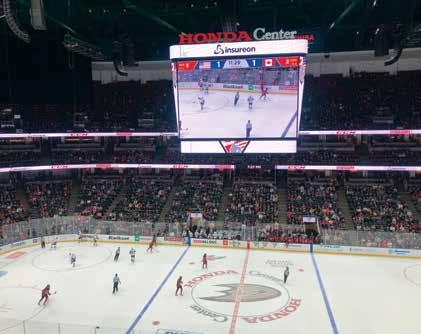
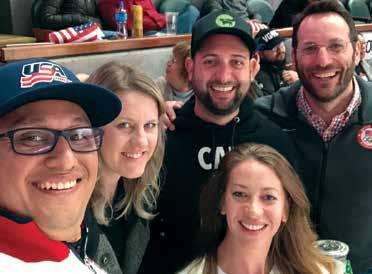

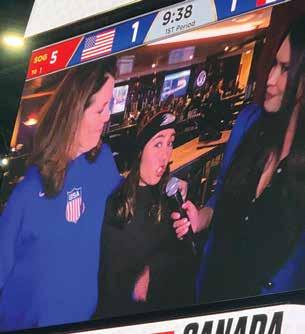
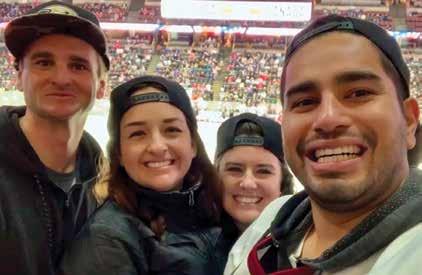


Sharing history is one of the best parts of my career. As the director of the Crawford Family U.S. Olympic & Paralympic archives and as an archivist it is my honor to preserve the history of the Olympic and Paralympic movements in the United States. But there is another aspect that is often overlooked and that is to provide access to history. If history is only captured and not shared, it does not benefit the greater good; it does not impart its knowledge to others. We are able to complete this task that archives know are vitally important through exhibits, displays and loans of Olympic & Paralympic artifacts
from our collections.
In the last couple of years, we have supported Team USA in Colorado Springs with the We Train Here lockers display at the Olympic & Paralympic Training Center (OPTC) in the Visitor Center. Your history is the first Olympic & Paralympic moment that visitors see as they pass through the entrance of the Visitor Center to take their tour of the OPTC. Such robust exhibits of the sports that call Colorado Springs their home.
In addition to the Visitor Center, we also create exhibits throughout the


USOPC headquarters that change every couple of years. Currently displays are focused toward Tokyo 2020 with a look back at the Olympic Games Tokyo 1964 and sports such as baseball and softball that will see a return to the Olympic Games. In addition, a large display in the building focuses on our Paralympic athletes and their accomplishments. Once again, each item used in these displays has been donated to the archives in an effort to preserve history. However, the result is that we are able to highlight numerous sports and athletes in our exhibits because of the diversity of our holdings. 1.

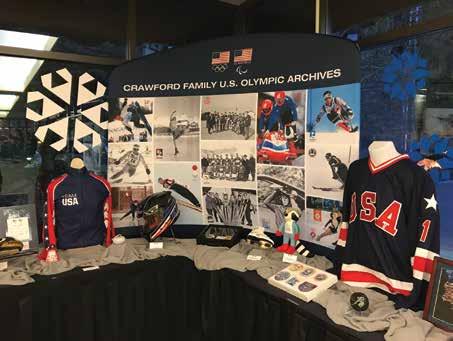
Exhibits are more permanent in nature, lasting two or more years; however, we also create temporary displays for Team USA special occasions and partner events. Media Summits of the past have incorporated historic displays to provide awareness of the long tradition of participation in the Olympic & Paralympic Games by Team USA athletes. The archives also curates displays for USOPA reunions as well as the Team USA Hall of Fame induction ceremony last fall. If requested, we can also supply a display for partner events such as the national sales meeting for USG or the Miracle on Ice tribute by the Vegas Golden Knights this past February.
Finally, one of the most visible means of assisting us in not only preserving history but providing access to it is through loans of our artifacts to the U.S. Olympic & Paralympic Museum opening the end of May. We will loan over 320 artifacts to the museum

to share with world and tell your history. While this is a phenomenal number of artifacts on loan at one time, it represents less than 3% of our artifacts. This ensures our ability to continue to support Team USA in exhibits and displays in the future as well as provides the museum the opportunity to refresh its displays through the years.
Each of the above methods allow us to share the history of Team USA to a greater audience and inspire others to achieve their dreams as our athletes have achieved theirs. We would not be able to provide the access to Olympic & Paralympic history without the support and donations of your history to us. When you donate the memorabilia that relates to your participation in the Olympic or Paralympic Games, you afford us the means to share that history with others and because of this, we thank you.


 4. 2017 Media Summit archive display. Photograph by Teri Hedgpeth
4. 2017 Media Summit archive display. Photograph by Teri Hedgpeth
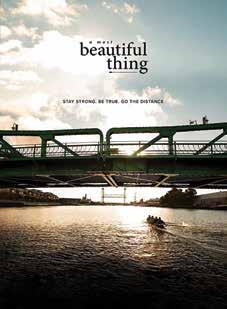
“A Most Beautiful Thing”, narrated by Academy Award-winning artist, Common, executive produced by NBA stars/Olympians Grant Hill and Dwyane Wade, along with Grammy-winning producer, 9th Wonder, and written/ directed by award-winning filmmaker Mary Mazzio (herself an Olympic rower), chronicles the first African American high school rowing team in this country (made up of young men, many of whom were in rival gangs from the west side of Chicago), all coming together to row in the same boat.
The film takes a deep dive into the backstories of these young men, examining the issues of trauma and violence. As the team’s captain, Arshay Cooper, reflected, “when we were on the water, we were in a place where we could not hear the sound of sirens or bullets, and that allowed us to shape
a different vision for ourselves, of who and what they could become.
These young men came together, after 20 years out of the boat, to race this past summer, not only to celebrate the team’s founding, but the fact that they are still alive. In an amazing gesture, they also reached out to Chicago Police Department officers to join their team. What then transpired was unexpected for all involved.
The film features Olympian David Banks, IOC member/Olympian Anita DeFrantz, Olympian/Olympic coach Mike Teti; and is funded by Olympians Tyler Winklevoss, Cameron Winklevoss and Ginny Gilder.
What’s Happening: The film will be released theatrically on June 12 (in Los Angeles, New York, Chicago, Boston, Oakland, Philadelphia, Miami and Washington D.C.).
Even more exciting, on Feb. 26, Representative Danny Davis (Chicago), along with other members of Congress, convened a panel/screening of the film, co-hosted by the Congressional Black Caucus, the Motion Picture Association and the Recording Association. The film will hopefully be used to help launch possible legislation on the urgency to address trauma in low income communities, particularly as it relates to children.
The Trailer: www.AMostBeautifulThing. com
Note: 50% of all profits from film screenings will be donated to support inclusion efforts in sports as well as trauma research in low income communities.)


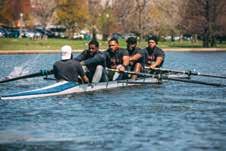
Scenes from “A Most Beautiful Thing”

Juggling the responsibilities of being both an NCAA and Team USA athlete just got easier for those who live in both worlds.
At the 2020 NCAA Convention in Anaheim, California, in January, the NCAA Division I Council passed athlete-focused legislation crafted by the United States Olympic & Paralympic Committee Collegiate Advisory Council to do just that.
The legislation, which began with feedback from Team USA national team student-athletes, coaches and National Governing Body administrators, permits athletes to train with their college coaches beyond the 20-hour-per-week rules, eases access to developmental training resources (i.e. sport experts, training experts and travel related to parents/experts) and extends parity to Paralympic national team studentathletes by including Paralympic references alongside Olympic waivers and exceptions. The DII and DIII Management Councils also approved the Paralympic parity recommendations during their meetings on Jan. 22.
The new legislation immediately impacts
nearly 170 student-athletes across more than 75 DI and DIII institutions – many of whom may compete at the Tokyo Olympic Games.
“Those reforms were built in response to the challenges identified by more than 300 national team studentathletes in 2018,” said Jamie Redman, USRowing Athletes’ Advisory Council representative and Yale University student-athlete alum. “These changes are vital in helping our most talented student-athletes succeed in the classroom and on the international athletics stage.”
The new legislation, which immediately goes into effect for eligible athletes who are designated by their NGB (or the international equivalent) and approved by the USOPC, is being implemented by proactively sharing best practices and resources with relevant collegiate stakeholders. The increased communication and collaboration will help student-athletes who navigate both worlds manage their high-performance training plans in the collegiate and international landscapes. “Our extraordinary Olympic and Paralympic national team studentathletes deserve all the fruits of our
unique collegiate athletics system: training, resources and guidance,” said Bob Bowlsby, Big 12 Commissioner and USOPC Collegiate Advisory Council pathway project chair. “These talented athletes represent our country’s best and we owe them the opportunity to represent our country to their fullest.” The legislation will impact more than 170 student-athletes across 60 DI institutions.
“On behalf of Team USA, we appreciate and applaud the collaborative efforts of the CAC, USOPC Legislative Task Force and the NCAA to support national team student-athletes,” said USOPC CEO Sarah Hirshland. “We will continue to work with schools, conferences and athletes to ease administrative burdens and ensure national team studentathletes can focus on their goals.”
The CAC formed in October 2017 and is chaired by Kevin White, USOPC board member and Duke University vice president and athletic director. The 10-member council is charged with increasing collaboration with NCAA member institutions and conferences to elevate national engagement and support of Olympic and Paralympic sport opportunities on campus.
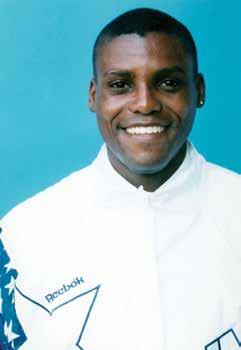


Sports Hall of Fame adds Carl Lewis, Mary Lou Retton, Rudy Tomjanovich
Olympic gold medalists Carl Lewis (track and field, 1980, 1984, 1988, 1992, 1996) and Mary Lou Retton (gymnastics, 1984) and former Rockets coach and player Rudy Tomjanovich (basketball coach, 2000) were honored in January as the third set of Houston sports greats selected for the Houston Sports Hall of Fame.
The selections of Lewis, Retton and Tomjanovich was announced by the Harris County-Houston Sports Authority, which sponsors the annual Houston Sports Awards.
Lewis and Retton, both longtime Houston residents since their competitive days, rank among the greatest athletes in their respective sports of track and field and gymnastics.
Tomjanovich played for the Rockets and then led the team to back-to-back NBA Finals championships in 1994 and 1995. He also coached the gold medalwinning U.S. team at the Olympic Games Sydney 2000 and coached the Los Angeles Lakers in 2004-05.
Retton will be the first woman to be honored by the sports authority, which in 2018 honored former Oilers running back Earl Campbell, former Rockets center Hakeem Olajuwon and former Astros pitcher Nolan Ryan. The agency last year honored former world heavyweight boxing champion George Foreman, former Oilers quarterback Dan Pastorini, four-time Indianapolis 500 winner A.J. Foyt and former Masters champion Jackie Burke.
Lewis, 58, won nine Olympic gold medals and a silver medal from 1984 through 1996. He is one of only three athletes to have won the same event, in his case the long jump, in four
successive Olympic Games, and at the Olympic Games Los Angeles 1984 he duplicated the feat of Jesse Owens in 1936 by winning four track and field gold medals in the 100 meters, 200 meters, long jump and 400-meter relay.
Born in Alabama and raised in New Jersey, Lewis came to Houston in 1979 to compete for the University of Houston under coach Tom Tellez and continues at his alma mater as an assistant track and field coach. He also won eight world championship gold medals along with one silver and one bronze medal.
Retton, 51, was born in West Virginia and came to Houston in the 1980s to train. She won five medals at the Olympic Games Los Angeles 1984, becoming the first U.S. woman to win the allaround gold medal. She also won two silver medals and two bronze medals in individual and team events.
After retiring from gymnastics, Retton
did product endorsements and hosted a children’s television show called “Mary Lou’s Flip Flop Shop.” She also competed last year in the ABC series “Dancing with the Stars.”
“I’m completely honored and humbled to be recognized so many years after my Olympics,” Retton said. “To be an inductee with Carl and Rudy is so amazing, and to be the first woman inductee is very special.”
Tomjanovich, 70, played for the Rockets from 1970 through 1981, moving to Houston in 1971 along with the franchise after its inaugural season in San Diego. He was selected five times to the NBA All-Star Game, and his uniform number 45 has been retired by the team.
As a coach from 1992 through 2003, Tomjanovich led the Rockets to their first and, thus far, only NBA championship and after the second title uttered one of the best-known statements in the history of Houston sports: “Don’t ever underestimate the heart of a champion.”
Former University of Tennessee star Tamika Catchings (basketball, 2004, 2008, 2012, 2016) and Lauren Jackson headline the list of 12 finalists for the Women’s Basketball Hall of Fame Class of 2020.
Catchings is a four-time Olympic gold medalist for the U.S. and a five-time winner of the WNBA defensive player of the year award. She led the Indiana Fever to their lone title in 2012 and Tennessee to an NCAA championship in 1998.
Jackson helped the Seattle Storm win two championships in the WNBA and was the league’s MVP three times.
The two former WNBA stars are joined by Swin Cash (basketball, 2004, 2012), who won three WNBA championships with Detroit and Seattle. She also won two NCAA titles at UConn.
Former Seattle coach Brian Agler was happy to hear his two former players were finalists.
“What separated Jackson from everybody else was how athletic she was for her size,” said Agler. “I had never

been around somebody like Swin who could compile All-Star numbers without running anything special for her. She did it on work ethic and sheer basketball instinct. The year we won it in 2010, she and Lauren both shot over 40% from the 3-point line and that sort of separated us from everybody else.”
The other finalists are DePaul coach Doug Bruno, USA Basketball national team director Carol Callan, former NCAA vice president for women’s basketball
Sue Donohoe, former USOPC member and college coach Lucille Kyvallos, official Lisa Mattingly, former Western Kentucky coach Paul Sanderford, Division II coach Bob Schneider, threetime AIAW champion point guard from Delta State Debbie Brock and ESPN vice president for programming and acquisitions Carol Stiff.
In addition to the 12 finals, the hall of fame announced that the 1980 U.S. Olympic women’s basketball team will be honored as the 2020 Trailblazers of the Game. That team didn’t participate in the Olympic Games because of the American’s boycott. That team included Anne Donovan and Carol Blazejowski and was coached by Sue Gunter with Pat Summitt as an assistant coach.
Meryl Davis, Charlie White entering U.S. Figure Skating Hall of Fame
GREENSBORO, N.C. (AP) — As they enter the U.S. Figure Skating Hall of Fame, Meryl Davis and Charlie White ponder just who they are joining in receiving one of the highest honors in their sport.
“One of the things that makes it so special is we are friends with and respect so much so many previous people who have gone into the Hall of Fame,” Davis said before the induction ceremony. “Scott Hamilton, Kristi Yamguchi, Brian Boitano — people we look up to and now we are in their company.”
As are 2006 world champion
Kimmie Meissner and the late Kathy Casey, one of American figure skating’s most successful coaches.
Davis and White, along with training
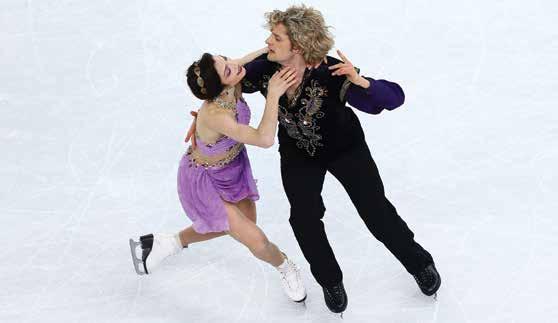
partners and friends Tanith Belbin and Ben Agosto, were at the forefront of bringing ice dance to previously unreachable heights for Americans. Once the abyss of the sport, Americans now tend to populate podiums in international competitions.
In 2010 at the Vancouver Olympics, Davis and White followed Belbin and Agosto four years earlier as silver medalists. At the Sochi Games in 2014, they edged Canada’s Tessa Virtue and Scott Moir, the 2010 champions, for the gold.
Davis and White won every U.S. title from 2009-14, plus two world crowns. But Davis and White were — and are — about so much more than their on-ice performances. He now coaches and she has been instrumental in the startup and development of Figure Skating in Detroit, an offshoot of the inner-city Figure Skating in Harlem program that has been a rousing success in New York City.
“When we were young skaters and took
the lay of the land of the sport,” White said, “we thought about becoming leaders of the sport. We recognized we would have a role as we were ascending, and we felt it was a real responsibility. Be thoughtful and considerate with anyone you deal with. We tried to let our skating do the talking as competitors, but we wanted the way we conducted ourselves off the ice to be professional and helpful to the sport.
“We have felt the responsibility because of everything skating has given to us to give back responsibly and, in the end, to always be grateful.”
Meissner, still one of the few American women to master the triple axel, also is one of those rare athletes to be a champion on all levels. She won novice, junior and senior (2017) U.S. titles.
Her performance at age 16 at Calgary worlds soon after finishing sixth at the Turin Olympics as the youngest U.S. athlete not only was a highlight of her career but of any world championships. “I was ready for that moment,” said
Meissner, who also coaches and is in school to become a physician’s assistant. “I had been practicing that way pretty much before the Olympic Games. It was nerves at the Games, and I was happy to salvage what I did.
“At worlds, I was not shocked at all that I skated clean at a time when it really needs to happen.”
Casey, who died in September, spent more than 50 years in the sport. She helped advance the biomechanical studies of jumps and was an expert at helping skaters correct technical aspects of their performances. In 2005, she was the U.S. Olympic & Paralympic Committee’s Sports Science Coach of the Year.
The official U.S. coach at three Olympic Games, Casey coached two-time U.S. champion Scott Davis (199394). She was the Professional Skaters Association president from 1989 to 1994, she was inducted into its hall of fame in 2008.


Five-Time Paralympian Alana Nichols takes over presidency role; new Trustees include Olympic champion, and professional and collegiate sports executives
New York, N.Y. (Jan. 7, 2020) — The Women’s Sports Foundation announced today a new president and five new members joining the board of trustees. Five-time Paralympian and sixtime Paralympic medalist Alana Nichols takes over as foundation president and is joined by newly elected board members Catherine Aker, Katrice Albert, Meghan Duggan, Darcie Glazer Kassewitz and Gloria Nevarez. Nichols and the new trustees join an elite group of cross-sector experts that help guide
the Women’s Sports Foundation’s operations as well as its mission, to unlock the possibilities in every girl and woman through the power of sport.
“We are thrilled to welcome our new president and board members, such a remarkably talented and accomplished group of professionals that share our passion for advancing gender equity in sport,” said WSF CEO Deborah Antoine. “All have demonstrated a steadfast commitment to our shared cause and bring a diverse breadth of experience and leadership to WSF. We are so excited to partner with them as we carry forward our foundation’s mission into 2020 and beyond.”
Nichols, who has competed in the Paralympic Games in wheelchair basketball, alpine skiing and canoeing, replaces outgoing president Elana Meyers Taylor, a three-time Olympic medalist in bobsled. She will serve a one-year term, providing her unique perspective and expertise, as well as visibility to WSF’s mission.
“Once I became an athlete, I came into my own and discovered my true self; that’s the power of sports - it can teach you, inspire you and challenge you to do and be your best no matter who you are, no matter what your capability is,” Nichols said. “That’s why I’m so passionate about the Women’s Sports Foundation. All girls, all women, all sports is such an incredibly powerful message. So many past WSF presidents helped pave the way for me; as president I hope to extend that legacy, especially for minority groups who haven’t been lifted up as much. I’m honored to have been elected and I’m excited for the year ahead.”
Nichols is a lifelong athlete who competed in a multitude of sports while growing up. During a Colorado ski trip in 2000,
she suffered a traumatic spinal cord injury while snowboarding which left her paralyzed from the waist down. Initially fearing her athletic career was over, that changed when she was introduced to wheelchair basketball her freshman year of college. Her passion reignited, she soon after accepted a scholarship from the University of Arizona to participate in their intercollegiate program for disabled sports, and later earned her master’s degree in kinesiology from the University of Alabama. Nichols is the first woman Paralympian to win gold medals at both Summer and Winter Games, having competed in wheelchair basketball, alpine skiing and canoeing. Though now retired from her Paralympic career, her sports drive continues via her passion for competitive surfing. Already an experienced WSF advocate, she previously served on the foundation’s Athlete Advisory Panel.
Nichols will be joined by incoming board members who hail from a wide range of backgrounds in professional and collegiate sports and will provide crucial expertise as the foundation progresses into 2020. Effective Jan. 1, 2020, the new members of WSF’s board of trustees will join Nichols in positions within WSF’s leadership:
Catherine Aker is in her fifth season with the Oakland A’s and her fourth as vice president of communications and community. In her current role she oversees both baseball and strategic communications, community engagement departments and the club’s charity arm Oakland A’s Community Fund. She is the club’s second female vice president and its first in nearly 30 years. Aker formed the ‘Women of the A’s’ which provides networking opportunities along with professional and leadership development for the
team’s female staff. Among her many accolades, she was awarded the 2017 Oakland Digital’s Community Leader, the 2018 Emerging Leader for Easy Bay Women in Business and was named one of the 2019 Most Influential Women in Bay Area Business by the San Francisco Times.
Katrice Albert is the NCAA’s executive vice president of inclusion and human resources. In this role, she leads efforts to enhance diversity, inclusion, leadership development, external engagement and strategic partnerships, in addition to human resource and performance management duties. Albert frequently
writes, speaks and consults on issues of intercultural competence,

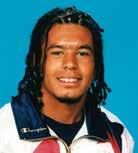
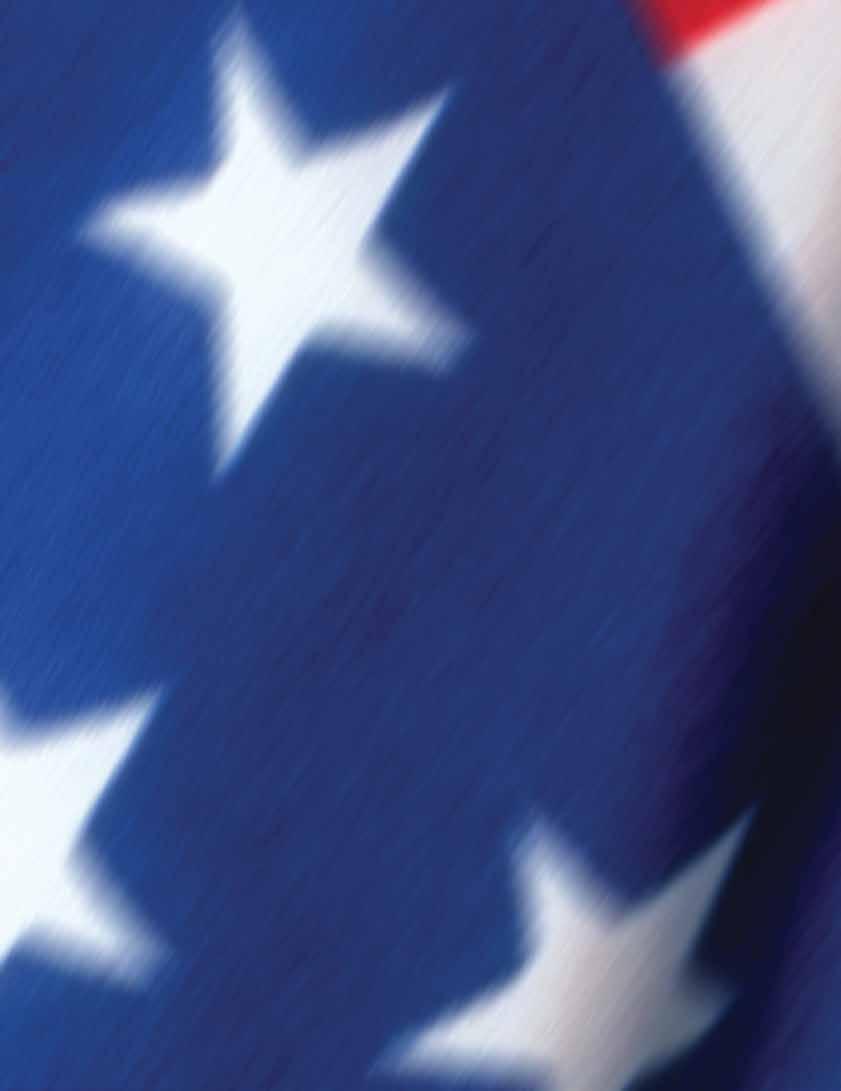
Larry Amar died on Jan. 21, 2020 at the age of 47.
Amar served as an assistant coach for the Golden Flashes from 2009-2018 alongside head coach Kathleen (Schanne) Wiler. Together they were a part of 105 victories and part of four Mid-American Conference tournament championships (2010, 2014-16). During his tenure, he earned his Bachelor of Science degree from Kent State in 2013.
After leaving Kent State, coach Amar joined USA Field Hockey as an assistant coach. It was a return to USA Field Hockey for Amar where he was the 1994 and 1995 U.S. Field Hockey Association Athlete of the Year and was a member of the program for 13 years.
Amar competed on several successful junior world cup and Pam American teams. He won five Olympic Festival medals – including two golds – and served as captain of the 1996 U.S. Olympic Team.
Following his playing career, Amar served for six years in the United States Army. He served two tours overseas, earning the rank of staff sergeant in the infantry. He earned two Army Commendation and Army Achievement medals among his multiple honors and achievements.
He will be ever so missed by his wife Abbey, the love of his life, his children Riley and Eli, whom he cherished, adored, and could not be prouder of. He will be incredibly missed by his father, Medrick Amar, (preceded in death by his mother, Mary Amar), Margaret Houck, brother Leo Amar and wife Kate, his in-laws Jim and Connie McKay, Michael and Shari McKay and nephew Brayden McKay.

Kobe Bryant died on Jan. 26, 2020 at the age of 41.
Bryant was a basketball phenomenon – a transcendent, if enigmatic, superstar whose rare talent bridged the gap between Michael Jordan and LeBron James in America’s National Basketball Association and in the global sport basketball has become. Bryant had retired only three years before his death, after a 20-year career in the NBA, all of it with the league’s most glamorous team, the Los Angeles Lakers, with whom he signed his first contract when he was only 17.
Five NBA championships and one Most Valuable Player award later, he retired with the third-highest total of points in league history, 33,643, the youngest player to cross that 30,000 barrier; his total was overtaken by James on the day before Bryant died.
Bryant grew up on basketball. His father, Joe “Jellybean” Bryant, played at La Salle University in Philadelphia, and then for the first half of an eight-year NBA career for the Philadelphia 76ers. His mother, Pamela, is the sister of Chubby Cox, another local star who played collegiately at Villanova University in Philadelphia. After the NBA, Joe played another eight years in Europe, seven of them in Italy, and though Kobe was born in Philadelphia, he spent much of his childhood in Italy, adopting Milan as his favorite football team. His name came from the Japanese steak his parents saw on a menu; his middle name, Bean, came from his father.
Kobe returned home to play basketball at Lower Merion high school in suburban Philadelphia. By his third year he was the target of college recruiters and was scrimmaging – taking part in practice games – against the 76ers’ players. Although he
could have had his pick of universities, after his senior year when he led Lower Merion to a state championship, averaging 31 points per game, he decided to forgo college and enter the NBA draft.
It was a gamble; but he was the first high schooler drafted in 20 years, and was a big man, as the others had been. At 6 feet and 6 inches, Bryant was very much a shooting guard, though tall for that position. Whether he was physically mature enough to take the demands of an 82-game season against grown men was a more pressing consideration than whether he was emotionally mature enough to handle it.
In the end, the Charlotte Hornets took him as part of a pre-arranged deal by which they traded him to the Lakers for the center Vlade Divac. As he was not yet 18, Bryant’s parents signed his contract.
He joined the Lakers at a time when they had also acquired the league’s top star, the 7 feet and 1 inch center Shaquille O’Neal. Bryant did not move into the starting lineup until his third season, but for the 1999-2000 campaign the Lakers general manager, Jerry West, hired Phil Jackson, who had coached Jordan’s Chicago Bulls to massive success, and he assembled a team of canny veteran players based around Bryant and O’Neal, who shared the scoring limelight. The result was three consecutive titles – in 2000, 2001 and 2002 – and superstar status for both Bryant and O’Neal. The two had disparate personalities: “when you ask Shaq to do something, he says no, sulks and does it,” said Jackson. “Kobe says OK, then does what he wants.”
In 2001, aged 22, Bryant married 18-year-old Vanessa Laine, whom he had met when she was dancing in a music video.
After a 2004 season that saw the Lakers add two more stars, Karl Malone and Gary Payton, but fall in the finals to the Detroit Pistons, Jackson was let go and O’Neal traded away. The Lakers were now firmly Bryant’s team, but after one disastrous year in which coach Rudy Tomjanovich quit in mid-season, Jackson returned. The Lakers improved slowly, though in 2006, Bryant scored 81 points in a game against the Toronto Raptors, the most anyone had
Lawrence J. “Larry” Amar (field hockey, 1996)
scored since Wilt Chamberlain’s 100 in 1962. They lost to archrivals Boston Celtics in the 2008 final, after a season in which Bryant won the league’s MVP trophy. The next two years saw Bryant’s fourth and fifth NBA titles; in 2010 the Lakers defeated Boston in the final game of a seven-game series.
Outside the U.S., Bryant’s profile was further lifted by his performance in the Olympic Games Beijing 2008; he was at his peak and turned in a spectacular showing against the hosts, China, plus a brilliant fourth-quarter burst that led the USA to the gold medal over Spain in the final, cementing his status as an international star. By the time of the Olympic Games London 2012, however, it was James who sparked another American gold-medal win in the final minutes, also against Spain.
The contrast between Bryant and James was telling: James went on to auction his services between teams, famously going to Miami after organizing his own “dream team” there, while Bryant stayed put in Los Angeles to build his Laker legacy, though after 2010 he would win no more titles. He was remarkably durable, playing through injuries until a ruptured Achilles sidelined him in 2013.
The knock-on effects of that condition slowed him down for his final three seasons and eventually he announced, with a poem called Dear Basketball, that the 2015-16 season would be his last. That swansong was his 20th with the Lakers, breaking John Stockton’s record of 19 years with one team (Utah Jazz). Bryant was voted on to the All-NBA Team of the best players for each season no fewer than 11 times and played in 18 All-Star games.
After his playing days he looked after his substantial business interests and led many charitable activities, including a fund for young people in China.
He wrote and narrated an adaptation of Dear Basketball for a short-animated film which won an Academy Award in 2018. And he returned frequently to Lakers’ games, recently with his 13-year-old daughter Gianna, a promising young player herself. He was flying with Gianna and others to a youth game, to be played at his own sports center,
when the helicopter in which they were flying crashed in the hills near Calabasas in California, killing everyone on board. Former President Barack Obama expressed a nation’s shock, noting that Bryant “was a legend on the court and just getting started in what would have been just as meaningful a second act”.
He is survived by Vanessa; daughters Natalia, Bianka and Capri; parents Joe and Pamela Bryant; sisters Sharia and Shaya.

Frank T. Burns died on Jan. 8, 2020 at the age of 67.
He came to the game through fortunate circumstance in 1974 and never left. Before he got to college, Burns had never seen a wheelchair basketball game and probably didn’t know it existed. But when the University of Wisconsin-Whitewater assigned him a roommate who happened to be a wheelchair user, it changed his life. And, in turn, that would impact the lives of so many others.
He left Whitewater and went to the University of Kentucky where he earned a master’s degree in therapeutic recreation but would return to coach the Warhawks to their first intercollegiate national championship.
His success on the bench reached the highest levels: head coach of Casa Colina Condors, the dominant team of the ‘80s with eight national championships from 1982-1990; head coach of the gold-medal men’s U.S. team at the Paralympic Games Seoul 1988; assistant coach of the world championship men’s U.S. national team in 1998 and the bronze-medal U.S. team at the
Paralympic Games Sydney 2000.
Burns was a teacher at his core and the common thread throughout his career was an emphasis on helping athletes gain access to sport and to the learning that would help them improve. It didn’t matter if it was at the local team level or on the elite national team stage, he had a penchant for motivating athletes and teams to get the most out of them.
More than a coach, Burns was a builder, helping grow the game and opportunities to play around the country by launching various new teams throughout his career.
Burns was a member of the Lakeshore Foundation team, which created various adaptive sports and coaching education programs both in Birmingham and throughout Alabama as well as the multisport National Paralympic Training Center. He conducted wheelchair basketball clinics in 17 different states and five countries, to include Japan, Korea, Bahrain, Canada and Mexico. He organized 20 years of National Wheelchair Basketball Association development camps. At the 1997 National Wheelchair Basketball Tournament in Birmingham, Alabama, Burns secured prime-time, national television coverage of the championship games. Burns was the NWBA executive director (2000-02), and most recently the chair of NWBA Hall of Fame Committee.
More than the game, Burns loved the people who played the game, those who coached it, and those who organized things so others could play. He cherished the history of those who built it to this point and the promise of those yet to come who would take it further, and he worked tirelessly to ensure that history would not be forgotten.
The only thing greater than his impact on growing the reach and quality of the game was the impact he had on the people he had a chance to work with. Coach, mentor and leader, he embodied the famous Will Rogers quote, “I never met a man I didn’t like.”
He possessed a gift for gab, combining loquacity and levity, dropping one-liners that would disarm anyone. At his core, he was a salesman and a visionary. He always held

close the ideal of what the NWBA could and should be and we are inspired by that every day.
During the past month that Frank was hospitalized, he used his time to remind us of the most compelling attribute about this organization: The NWBA is a family.
We are grateful to the Burns family for their ongoing communication with us throughout the process and they appreciate all the love sent Frank’s way. Just as importantly, we thank them for sharing their brother with us.
Frank loved the game and the game loved him back. He will be missed but never forgotten.

Harry Groves died on Feb. 23, 2020 at the age of 89.
Harry served as a first lieutenant in the United States Army and attended Temple University where he obtained a bachelor’s in education. He then attended the College of William & Mary to obtain his master’s degree. Groves was a track and cross-country coach for 53 years, working at Penn State University as the head coach for 38 years; William & Mary as the head coach for 12 years and assistant coach for one year; and Fort Eustis in Virginia as the head coach for one year. He won numerous awards and accolades as a coach and was selected as head or assistant coach for many national and international events, including the Olympic Games Barcelona 1992.
In addition to his love of track and field, he enjoyed being outdoors, running and walking, fishing and chatting with friends and strangers wherever he went.
Groves is survived by five children: Marianne Wilkes and her husband, Gary; Roger Groves and his wife, Frances; Terri Groves and her husband, Marc; Kelly Duarte and her husband, Eduardo; and Matthew Groves; three grandchildren, and two brothers, Chas Groves and his wife, Patty, and Bill Groves. In addition to his parents, he was preceded in death by a daughter Melissa Groves.
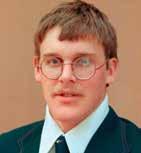
1968, 1972)
William “Bill” Hobbs died on Jan. 4, 2020 at the age of 70.
Hobbs lived a large and loud life, both literally and metaphorically. Towering over 6 feet tall, with shoulders so broad that bulls longingly eyed them, he took up a lot of space in the lives of the people who knew and loved him. Born on July 30, 1949 to Marge and Franklin Hobbs, Bill was the second of four children. He, Fritz, Helen and Matthew enjoyed a childhood filled with adventures, neighborhood friends, ski trips, Muscovy ducks raised in the backyard and summers at Nonquitt, Massachusetts.
A massive nerd, Hobbs concentrated on math and physics both at Milton Academy and at Harvard University. And because he refused to conform to a tidy stereotype, he also played freshman football and rowed freshman crew, and then continued to row for the varsity crew team for three years. He is the only man at Harvard to have ever pulled so hard that he broke an oar, and at least one person believes that it is for this accomplishment alone that Hobbs earned election to the Harvard Athletic Hall of Fame.
Hobbs’s shoulders served him well as an oarsman during the Olympic Games New Mexico 1968 and the Olympic Games
Munich 1972. In the former he placed fifth in a pair with coxswain, while in the latter his crew (the self-titled “Alte Achter”) brought home the silver medal. He was later elected to the National Rowing Hall of Fame.
Hobbs returned to Milton Academy to teach math and serve as a Wolcott House floor monitor and advisor. He then moved back to Cambridge, Massachusetts, to receive his MBA from Harvard Business School. During his career he focused on manufacturing, because much as most people coo over puppies and kittens, Hobbs cooed over very big machines that did very cool things, used a lot of power and made a lot of noise. He began at Food Machinery Corporation, which sent him to Brazil (one of 68 countries he visited in his lifetime), and several places including Lexington, Kentucky, where he purchased and lived on a farm. There, he finally did get his own bull to contend with, a Belted Galloway – but that’s another story. As CEO of Bridon American, he founded Certex distribution in 20 countries. Later, he served as CEO of Trend Technologies and J.C. Whitney, among others, and at the inception of High Road Capital Partners, Hobbs joined as an operating partner.
His greatest accomplishments, however, were personal. He managed to convince a wonderful woman to stand at the altar and say, “I do,” and together they produced four children in five years. Hobbs’s first rule as paterfamilias was “no fun without Dad,” and Chrissy, Bart, Ben and Julia quickly learned that the rule would be strictly enforced. The competitive spirit that led Hobbs to two Olympic Games did not make concessions for his children. Backyard games of soccer, touch football, kick-the-can and water polo often ended with every child on the opposite team piling on Hobbs while he used his bull shoulders and massive frame to plow his way to victory. The greatest moment of his children’s lives might be the day that Bart, during a typically vicious backyard water polo game, proved himself strong enough to keep Hobbs in check and finally gave him a taste of the medicine he had been feeding his children for decades.
Hobbs would read anything and had an opinion about everything; anyone who lived with him knows that no matter where in the house he was, and no matter where in the

house you were, Hobbs’s voice could always be heard. Even when he was not in the room with you, his presence was always felt. The quiet is going to be a new experience for everyone who loved him.
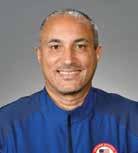
Edgar Laforest died on Feb. 5, 2020 at the age of 52.
Laforest made his international debut at the 2006 World Para Volley World Championships and concluded it with being named to the 2016 U.S. Paralympic Men’s Sitting Volleyball Team. He competed in three world championships and three Parapan American Games during his time with the national team. Laforest earned three silver medals at Parapan American Games, along with a gold at the 2009 Parapan American Championships.
“Edgar was an incredibly great advocate for our sport,” U.S. Men’s Sitting Volleyball National Team head coach Greg Walker said. “He has a long history of being an athlete and respected volleyball coach as well as being an active international official. He was involved with the sitting volleyball team long before I started working with the team and will be remembered and honored by his teammates and family.”
Laforest became disabled in 1988 following a serious car accident during which a drunk driver struck him alongside a road causing severe and permanent damage to both legs. As a standing volleyball player prior to the accident, he stayed involved in the sport afterwards by becoming a referee. Laforest earned his international referee badge in 2005. Through a friend, he met then U.S. men’s sitting team head coach Bill Hamiter, who encouraged him to join the sitting
team program. One year after becoming an international referee, Laforest earned a spot on the U.S. men’s sitting team.
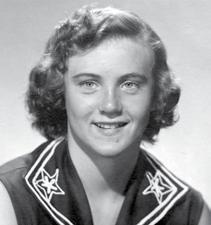
Coralie M. O’Connor died on Dec. 31, 2019 at the age of 85.
O’Connor’s desire to become a world-class swimmer surfaced early and drove her to practice no matter what the obstacles. She began her training at the Lincoln Square Boys Club, during a time when woman was not allowed in the club. As a recent graduate of Classical High School, she qualified for the Olympic Games Helsinki 1952 by finishing third in the nationals in the 100-meter backstroke. O’Connor’s swimming feats didn’t end with the Olympic Games. In 1955 while a junior at Purdue, she was the national Amateur Athletic Union backstroke champion and an All-American. That same year, she competed in the Pan American Games in Mexico City and won a silver medal in the 100-meter backstroke and a gold medal with the relay medley team.
O’Connor founded the Worcester Swim Club, teaching competitive swimming to countless city youngsters. Although she always had regrets of never producing an Olympian, the WSC won many team and individual trophies. She was a member of the National Swimming Hall of Fame and the first woman to be inducted into the Worcester Boys and Girls Club Hall of Fame, she was also the first woman to coach a male varsity sport at Worcester Academy in the 1970s.
O’Connor also spent more than three decades teaching physical education in the Worcester public schools, most recently at South High School. She was a longtime member and volunteer at All Saints Church.
She leaves a niece, Suzanne Criswell and her husband, Gary; a nephew, Paul Garcia and his wife, Kim; great-nephews, Chad Minton and his wife, Christina and their son, Luke; Scott Minton and his wife, Caitlin; Connor Garcia, Brandon Garcia and three cousins, Donna Scott, Gayle Turner and Coral PrinceWilson. Her brother, Paul H. O’Connor and her sister, Lois Ann Garcia predeceased her.

Sandor “The King” Rivnyak (team handball, 1972, 1976)
Sandor Rivnyak died on Jan. 22, 2020 at the age of 82.
Rivnyak was a goalkeeper for the U.S. Olympic handball team in the Olympic Games Munich 1972 and the Olympic Games Montreal 1976. He grew up in Hungary but defected to the United States in 1960 and became a naturalized U.S. citizen. Because of his youth in Hungary, Rivnyak had the most experience in handball of any U.S. player in 1972 and 1976 and played in over 60 international matches. He worked as a photo restorer and retoucher.
He was one of a kind and will be missed by so many who knew and loved him. RIP Sandor.
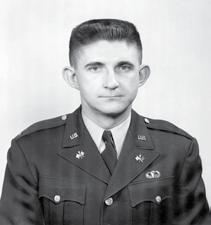
Herbert “Herb” B. Voelcker Jr. (shooting, 1956)
Herbert Voelcker Jr. died on Jan. 23, 2020

at the age of 90.
Voelcker Jr. was born in Tonawanda, New York, to Julia O’Connor Voelcker and Herbert B. Voelcker Sr. He attended Tonawanda schools and considered himself a “river rat,” sailing his own small sailboat (built with his father) on the Niagara River.
An excellent student, Voelcker graduated from the Massachusetts Institute of Technology in 1951 with a Bachelor of Science degree in mechanical engineering. While at MIT, he was both the stroke of the lightweight crew and the captain of the university’s rifle team, and a member of the Beta Theta Pi fraternity.
Voelcker was also a Distinguished Military Graduate of the Reserve Officers Training Corps. Upon graduation, he received a commission in the regular U.S. Army Signal Corps. He served as a signal officer in the 82nd Airborne Division for two years. The Army then sent him back to MIT, where he earned a Master of Science degree in electrical engineering in 1954.
While in graduate school, Voelcker met Jean Hunter through an introduction by his sister Mary. Both women were then seniors at Wellesley College. Voelcker and Hunter’s first date was on a cold, windy March 1954 day. He invited her to join him in sailing a rather leaky Tech dinghy between the bridges on the Charles River. He was greatly impressed with her ability to crew without mentioning that she was drenched and freezing. They married in December that year.
Starting in 1955, Voelcker discovered the joys of research after being posted to the U.S. Army’s Signal Labs at Fort Monmouth, New Jersey. This set him on his future career as a research engineer and professor. During that time, he was also a member of the U.S. Army rifle team, traveling to Melbourne, Australia, to compete in the Olympic Games.
Voelcker resigned his commission at the rank of captain when he received a two-year Fulbright Fellowship in 1958, enabling him to study at the Imperial College of Science in London. The college granted him a doctorate in electrical engineering in 1961, after which Voelcker and Hunter returned to New York State.
He started teaching at the University of Rochester as an assistant professor of electrical engineering. In 1969, he was awarded the university’s Edward Peck Curtis Award for Excellence in Undergraduate Teaching, a remarkable honor so early in his career.
He is well known for founding the Production Automation Project in 1972, leading the research team that developed mathematical foundations and core algorithms for solid modeling—the enabling technology for modern mechanical computer-aided design.
In 1985, Voelcker became the head of a new directorate for advanced manufacturing technologies at the National Science Foundation in Washington, D.C., but a reorganization less than a year after he arrived curtailed the goals of his unit, so the Voelker’s spent only a single year in the nation’s capital.
Returning once more to upstate New York, Voelcker was the first recipient of a new teaching position at Cornell University, the Charles W. Lake Jr. Chair. With two adult sons out on their own by then, Voelcker and Hunter lived for more than three decades in Ithaca—their longest tenure in any one location.
While he retired from full-time teaching in 2000, Voelcker became professor emeritus. He continued to teach one course a year through Cornell’s 2019 academic year, and had planned to do so again in early 2020.
His research during a 60-year career ranged over radio propagation, aural perception and bandwidth compression in the 1950s; modulation theory and digital signal processing in the 1960s; computer science and solid modeling in the 1970s; machine tools and numerically-controlled programming systems in the 1980s; and parallel computation, dimensional tolerancing and mechanical design during the 1990s. Following his 2000 retirement, his part-time technical work focused largely on assembly modeling and variation control in mechanical design and manufacturing. The National Science Foundation provided financial support to many of these efforts.
Among his professional honors, Voelcker
was a life fellow of both the Institute for Electrical and Electronics Engineers and of the American Society of Mechanical Engineers. In 2007, along with engineering professor Aristide Requicha of the University of Southern California, one of his early Ph.D. students, he received the inaugural Prix Bezier, the senior prize of the International Solid Modeling Society, for fundamental contributions to solid modeling.
Two years later, he was named a 2009 Master of Manufacturing by Manufacturing Engineering, the magazine of the Society of Manufacturing Engineers. And in 2014, he received a Lifetime Achievement Award for his work in industrial automation from ASME’s Computers in Information in Engineering Division.
During the 1990s, Voelcker and Hunter returned to the water, piloting a succession of various cruisers throughout the Northeast, the St. Lawrence Seaway, the Intercoastal Waterway and other recreational routes. They jointly designed the layout and interior of the Rover, a 37-foot craft built in Maine on the hull of a lobstering trawler, taking delivery in October 2002. The last boat Voelcker built, after a gap of more than half a century, was a wooden Nutshell Pram that served as the dinghy on the Rover.
He is survived by his wife of 65 years, Jean; two sons, John and Edward (Ned); his sister Mary Doino; her son Jay Doino; and daughter Mary Kathryn Bausch (Rick); and their children Jack and Ana Bausch.
OFFICIAL USOPA SOCIAL NETWORK: athletenetwork.com/usopa
OFFICIAL TEAM USA NETWORK: teamusa.org/Team-USA-Athlete-Services/Alumni
Join our private groups on Facebook and LinkedIn to stay connected.
FACEBOOK:
United States Olympians and Paralympians
1,136 members
LINKEDIN:
United States Olympians and Paralympians (364 members)
Olympic and Paralympic Alumni (12,876 members international)
CONNECT WITH LA 2028:
Youtube: youtube.com/channel/UC0HoUCfNT_13tkuxvtdnyA
Instagram: instagram.com/la2028Games/
Twitter: twitter.com/LA2028
Facebook: facebook.com/la2028/
PRESIDENT
Dick Fosbury (Track and Field, 1968)
Contact: rfosbury68@gmail.com
VICE PRESIDENTS
Charles Altekruse (Rowing, 1980, 1988)
Contact: caltekruse@caconsult.org
Allison Baver (Speedskating, 2002, 2006, 2010)
Contact: allison@allisonbaver.com
Carol Brown (Rowing, 1976, 1980, 1984)
Contact: carolpb@msn.com
Candace Cable (Para Track and Field; 1980, 1988, 1992, 1996/Alpine Skiing; 1992/Nordic Skiing; 1994, 1998, 2002, 2006)
Contact: candace@candacecable.com
Anne Warner Cribbs (Swimming, 1960)
Contact: acribbs@basoc.org
Carol Lewis (Track and Field, 1980, 1984, 1988)
Contact: misscarol63@gmail.com
Iris T. Zimmermann (Fencing, 2000)
Contact: zimmermann.iris@gmail.com
USOPA SPECIAL OFFICER
Jan Palchikoff (Rowing, 1976, 1980)
Contact: jpalch3@gmail.com
IMMEDIATE PAST PRESIDENT
Gary Hall Sr. (Swimming, 1968, 1972, 1976)
Contact: garyhallsr@mac.com
PAST PRESIDENTS
Willie Banks (Track and Field, 1980, 1984, 1988)
Contact: bankshw@hotmail.com
John Naber (Swimming, 1976)
Contact: john@johnnaber.com
Bill Toomey (Track and Field, 1968)
Contact: williamtoomey@gmail.com
DIRECTORS
USOPC Chairman
Susanne Lyons
Anita L. DeFrantz (Rowing, 1976, 1980)
David Haggerty
Kikkan Randall (Cross-Country Skiing, 2002, 2006, 2010, 2014, 2018)
Robert Bach
Rich Bender
Cheri Blauwet (Para Track and Field, 2000, 2004, 2008)
Beth Brooke-Marciniak
Bill Marolt (Alpine Skiing, 1964)
Steve Mesler (Bobsled, 2002, 2006, 2010)
Vivek H. Murthy
Whitney Ping (Table Tennis, 2004)
Brad Snyder (Para Swimming, 2012, 2016)
Kevin White
Robert L. Wood
Sarah Hirshland
USOPC Chief Executive Officer
Sarah Hirshland
EDITORIAL STAFF
SENIOR EDITOR
Cynthia E. Stinger (Team Handball, 1984, 1988, 1992)
ASSOCIATE EDITOR
Christine Taylor
COPY EDITOR
Kendra Hansey
PRODUCTION DIRECTOR
O’Shea Design
Photos by: Getty Images, Duomo, Crawford Family USOPC Archives, AP and other sources.
Alabama Olympians & Paralympians
President: Jennifer Chandler Stevenson (diving, 1976) (205) 313-7436
Arizona Olympians & Paralympians
President: TBD (elections pending)
Austin-San Antonio Olympians & Paralympians
President: Randy Lipscher (field hockey, 1984) (512) 699-0962
Colorado Olympians & Paralympians
President: Michelle Dusserre Farrell (gymnastics, 1984) (719) 330-4030
Dallas/Fort Worth Olympians & Paralympians
President: Sammy Walker (weightlifting, 1976) (469) 955-3158
Florida Olympians & Paralympians
President: Carrie Zimmerman (gymnastics, 1976) (850) 212-7846
Georgia Olympians & Paralympians
TBD (elections pending)
Hawaii Olympians & Paralympians
President: Dan Drown (water polo, 1964) (808) 295-7840
Houston Olympians & Paralympians
President: Jacqueline Washington (track and field, 1984) (832) 488-8573
Idaho Olympians & Paralympians
President: Dick Fosbury (track and field, 1968) (208) 720-2352
Indiana Olympians & Paralympians
President: Ollan Cassell (track and field, 1964) (317) 253-1162
Louisiana Olympians & Paralympians
President: Hollis Conway (track and field, 1988, 1992) (318) 237-2382
Michigan Olympians & Paralympians
President: Gary F. Morgan (track and field, 1988) (248) 396-4936
Midwest Olympians & Paralympians
President: Diane Simpson (rhythmic gymnastics, 1988) (847) 452-7843
Minnesota Olympians & Paralympians
President: Katrina Radke (swimming, 1988) (651) 335-3647
Missouri/Illinois Olympians & Paralympians
President: John Carenza (soccer, 1972) (314) 662-4990
National Capital Area Olympians & Paralympians
President: Arlene Limas (taekwondo, 1988) (540) 720-1988
Nevada Olympians & Paralympians
President: Dean Willeford (water polo, 1968) (775) 827-1775
New England Area Olympians & Paralympians
President: Sharon Ann Jewell (taekwondo, 1988) (404) 668-7896
New Mexico Olympians & Paralympians
President: Trish K. Porter Topmiller (track and field, 1988) (505) 459-9732
Northern California Olympians & Paralympians
President: Julia Nichols (rowing, 2012) (925) 577-7638
NY, NJ, CT Olympians & Paralympians
President: Craig Gilbert (team handball, 1984) (973) 975-2807
Oklahoma Olympians & Paralympians
President: Josh C. Davis (swimming, 1996, 2000) (210) 889-7667
Oregon Olympians & Paralympians
President: John McArdle (track and field, 1980) (541) 917-4210
San Diego Olympians & Paralympians
President: Erin Aldrich-Shean (track and field, 2000) (214) 725-9926
Southern California Olympians & Paralympians
President: John Moffet (swimming, 1980, 1984) (310) 994-4647
Utah Olympians & Paralympians
President: Bill Schuffenhauer (bobsled, 2002, 2006, 2010) (385) 237-7037
Washington Olympians & Paralympians
President: Caroline Holmes (gymnastics, 1968) (206) 246-2934
Western PA-OH-WV Olympians & Paralympians
TBD (elections pending)
No chapter in your area?
Interested in starting a chapter?
Contact the U.S. Olympians & Paralympians Association office for details at: (800) 717-7555
www.teamusa.org